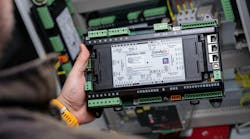NEW YORK – Robert Scoble works on the front lines of virtual reality. As the entrepreneur in residence at Upload VR, Scoble has been test-driving the latest technology from pioneers like Magic Leap and Oculus.
“In the next five years we’re going to see an amazing change,” Scoble. “It’s mind-blowing. People are freaked out by it.”
If it becomes widely adopted, virtual reality is likely to have a mind-blowing impact on networks and data centers.
“It’s going to need a lot of software and a lot of infrastructure,” Scoble told an audience of data center professionals at DatacenterDynamics Enterprise. “So you guys will all have jobs for a while.”
Virtual reality (VR) allows users to interact with digital environments and objects, typically using a headset. When you turn your head, you see other areas of a 360-degree digital environment. Some VR apps include controllers that allow users to manipulate digital objects.
But these 360-degree video applications require a LOT of data, and delivering these experiences across the Internet presents a major challenge. A video at the 6K resolution used by the GearVR headset could be 20 times the size of today’s full HD video. All that data will have to move across the network, and in some cases be cached locally to assure low latency.
That’s why Facebook, a pioneer in both VR and data centers, has created a new project to boost the world’s bandwidth. The Telecom Infra Project seeks to “reimagine infrastructure” to deliver the data-intensive video and virtual reality workloads of the future. Facebook is also working on video compression technologies, and sharing its advances with the industry.
“Scaling traditional telecom infrastructure to meet this global data challenge is not moving as fast as people need it to,” said Jay Parikh, Global Head of Engineering and Infrastructure at Facebook. “We know there isn’t a single solution for this, and no one company can tackle the problem alone.”
New Tech Shaping IT Infrastructure
Today we continue a series of stories looking at the emerging technologies that will shape the future of the data center. Virtual reality, machine learning and the Internet of Things will require unprecedented levels of computing horsepower, connectivity and data storage. As these technologies move toward the mainstream, they will drive major changes in IT infrastructure.
Many remain skeptical about the potential for virtual reality, and the pace of adoption is hard to predict. As a technology evangelist at Microsoft and Rackspace, Scoble has had a front-row seat for the emergence of cloud computing. He believes virtual reality will also be a transformative technology, and will see meaningful consumer adoption in three to five years.
After years in development, Scoble says, virtual reality is now creating amazing experiences. And people will want more.
Robert Scoble (right), the entrepreneur in residence at virtual reality news hub Upload VR, described the latest developments with VR technology in his keynote at DatacenterDynamics Enterprise in New York. (Photo: Rich Miller)
“I’ve now seen hundreds of people get their first demo in places all over the world,” Scoble writes. “Same smiles every time. In my experience, at least, the smiles don’t wear off.”
Virtual reality “will have deep implications on what it is to be human for quite some time,” he adds. “The bleeding edge is just starting to dream about how these will change our lives and businesses.”
Tech Titans Making Big Bets in Virtual Reality
At DatacenterDynamics, Scoble provided an overview of the emerging virtual reality landscape, which includes at least none companies developing glasses or headsets for augmented reality. These include:
- Magic Leap is a Florida-based startup backed by Google, Alibaba, Qualcomm and Warner Brothers. It is developing technology to combine our digital and physical lives, generating images that are indistinguishable from real objects and placing them into the real world.
- Facebook’s Oculus technology includes the long-awaited Oculus Rift headset, which will hit retail stores this week. Facebook paid $2 billion to acquire Oculus, which also is developing VR Touch controllers, and an application environment called Toybox that allows you to play virtual ping pong with an opponent halfway across the world.
- SnapChat also has ambitions in the VR headgear market. Last year it acquired the maker of Epiphany Eyewear, which has built-in HD video capabilities. “SnapChat’s going to have a connected camera this year,” said Scoble. Meanwhile, the company has been hiring virtual reality specialists.
“This is really advanced computer science,” said Scoble, and it will require advanced infrastructure.
It’s one thing to deliver virtual reality to a desktop computer or gaming console, which is the starting point for Oculus. The integration of VR and augmented reality into eyewear will require a leap ahead in mobile networks.
Facebook’s Vision for a Virtual Future
The best window into the potential impact of virtual reality is provided by Facebook. The company has built a massive global infrastructure to support its 1.65 billion users, which has scaled to handle massive uploads of photos and HD video.
Oculus and virtual reality are a key piece of Mark Zuckerberg’s vision for the future of Facebook and social media.
The Facebook Oculus Rift virtual reality headset, which hits retail stores this weekend. (Photo: Oculus)
“After games, we’re going to make Oculus a platform for many other experiences,” said Zuckerberg. “Imagine enjoying a court side seat at a game, studying in a classroom of students and teachers all over the world or consulting with a doctor face-to-face – just by putting on goggles in your home. This is really a new communication platform.”
To realize that vision, Facebook says, global digital infrastructure will need a major upgrade. Facebook, Google and Microsoft all have projects to bring wireless connectivity to the developing world, using everything from balloons to drones to satellites.
The Telecom Infra Project (TIP) extends that effort. Parikh said Facebook and its partners hope to “reimagine traditional approaches to building and deploying telecom network infrastructure.”
“By 2020, more than a zettabyte – that’s 1,000 exabytes – of information will be exchanged over telecom networks, much of it in data-intensive formats like video and virtual reality,” said Parikh. “Innovation in the telecommunications industry must keep pace with these increasing demands so we can continue to scale coverage around the globe and meet future connectivity requirements. TIP provides a nexus for everyone in the industry to come together to solve the hardest problems.”[clickToTweet tweet=”Facebook’s Jay Parikh: By 2020, more than a zettabyte of data will be exchanged over telecom networks.” quote=”Facebook’s Jay Parikh: By 2020, more than a zettabyte of data will be exchanged over telecom networks.”]
Facebook is also doing advanced work on compression and encoding technologies for VR, and is sharing its work.
“Both 360 video and VR create immersive environments that engender a sense of connectedness, detail, and intimacy,” Facebook’s Evgeny Kuzyakov and David Pio wrie on the company’s engineering blog. “All this richness creates a new and difficult set of engineering challenges. The file sizes are so large they can be an impediment to delivering 360 video or VR in a quality manner at scale.”
The Facebook team has made refinements to how 360 video is displayed using cube maps. This approach has reduced file sizes by about 20 percent.
“Our work in VR is still early, and there are a lot of hardware and software challenges that we still need to solve,” the Facebook engineers report. “But we’re encouraged by our progress to date.”
Virtual Reality, Real Infrastructure
The burden of delivering virtual reality technology will focus on the network. But the file sizes will require storage and data center infrastructure.
Equinix has always been at the intersection of the network and the data center. Thus, it’s not surprise that the colocation and interconenction specialist is the first data center operator to join the Telecom Infra Project, along with the Open Compute Project’s telco initiative.
“It will be a place to push the limits of technology and develop tomorrow’s interconnection solutions,” said Ihab Tarazi, the CTO of Equinix.
They’re not alone in watching the horizon for signs of demand for VR-related infrastructure requirements.
“This may be early, but we’re keeping a close eye on virtual reality,” said Tony Wanger, President of colocation provider IO.
Many data center professionals industry may be familiar with virtual reality through Google’s use of the technology to provide a tour of one of its data centers in The Dalles, Oregon. The video is optimized for Google Cardboard and a VR device, but displays as 360 video in your web browser, as seen above. As you watch the video, click and drag your cursor to get a full 360-degree view of Google’s servers. It’s as though you are standing there.
Google’s data centers are among the most restricted environments on the planet earth. Virtual reality allows Internet users from across the globe to experience what it’s like to walk through one. The allure of this technology is clear.
It may take several years for the potential impact of virtual reality to become apparent. But if the technology succeeds, it will require better latency – which could mean more storage in current data center hubs, as well as more edge data centers to distribute content. If virtual reality becomes the everyday communications tool envisioned by Facebook’s Zuckerberg, the data center industry will be in building mode for some time to come.
“Virtual reality was once the dream of science fiction,” said Zuckerberg. “But the internet was also once a dream, and so were computers and smartphones. The future is coming and we have a chance to build it together.”
About the Author



